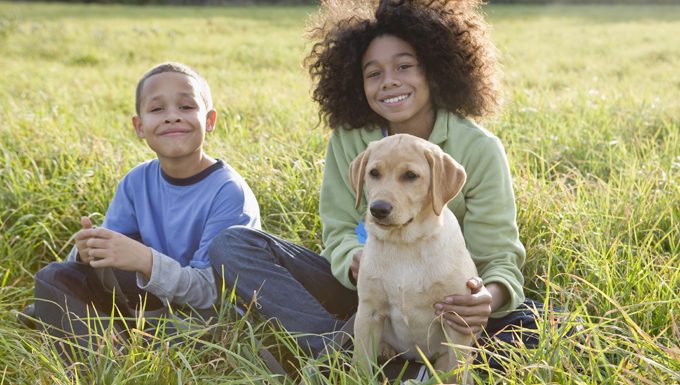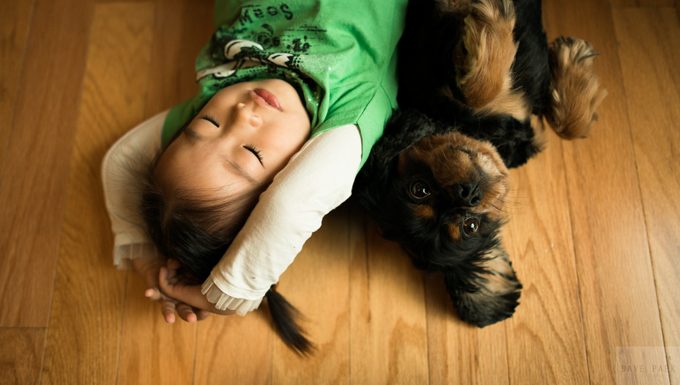The death of a pet is the first loss that many of us can remember. That relationship makes an impression forever — and it’s a death that will be never be forgotten. That’s why you so often see the online security question, “What was the name of your first pet?”
As a parent, knowing the best way to assist your child in this loss can be overwhelming, especially when you are also trying to deal with your own grief.
So how should you go about helping your child deal with the loss of a pet? Here are a few words of advice.
Don’t Set Rules About Mourning

Many parents feel that they have a responsibility to their child to be strong, to hide emotion and never let them see you cry, as that may upset the child even more.
Quite the contrary. Children are absolutely fabulous when it comes to the rituals of mourning. In fact, they are organic mourners and often instinctively know how to deal with loss.
Adults often place too many societal rules on the process and try to conform to what grief should look like or what they hear from others about the protocols on mourning.
Children do it right, so our role is to let them.
Children will usually grieve in short, intense doses and will then distract themselves to ease the pain. They will often let in just a bit of their emotion at a time, will turn to a distraction such as play, and then will allow a bit more of the emotion.
Therefore, many parents will watch this process and assume that their child is “fine” because they don’t take the entire emotion in at one time, like adults do. Or they will describe the child as “aloof” because they keep finding distractions.
This is why children will many times be referred to as “forgotten mourners” because their process of dealing with death is done through dosing. However, children need to be given a safe environment and the safety of expression to be fully brought into a healthy mourning process.
Say Goodbye — It’s Okay To Cry

Let’s talk about a variety of ways to help the child through the loss of a pet.
First of all, allow the child the opportunity to say goodbye to the deceased pet friend. This is one of the first steps in the healthy aspect of dealing with the loss.
As humans, we process most information through our eyes, so seeing a deceased being confirms that the death is real — and, of course, the child is going to cry. Don’t be scared of the outward showing of this emotion.
Your role as a parent is to give the child the permission to show this emotion and to provide a safe place — including a warm hug and in your arms — to do this.
Help them with the proper words to use also. It’s okay to say “die” or “dead.” Use the right words, and as hard as it is, make this a teachable moment that they will forever remember.
On a side note, you know the maturity of your child better than anyone. Therefore, the topic of children being present for euthanasia is one that has to be unique to the child, their age, and maturity level.
Being a part of euthanasia and having the opportunity to say a final goodbye are two separate events. Don’t confuse the two, and always allow the child the opportunity for their goodbyes. It should be your call as the parent in determining if your child can handle the event of the euthanasia.
Remember With Rituals, Memorials, & Tributes

Next, as a caring parent, there are a variety of rituals that you can do with your child to encourage their mourning and to honor their memories of their beloved pet.
These can help your child express their grief in a healthy way and learn to accept loss.
Consider these activities:
- Write a letter to the pet or about the pet. You can find resources to help you start at Two Hearts Pet Loss Center.
- Plant a flower in the pet’s memory.
- Set up a tribute table at home that will showcase all of the things that were important to that pet as a part of the family.
- Consider having a Celebration of Life ceremony where the child is allowed to talk about the pet, what they will always remember, what lessons the pet taught them, and what they will miss most.
- Help them start a donation drive to support a local shelter or rescue group.
- Make a scrapbook.
- Make a stepping stone to place outside in the flower beds to forever honor where that pet liked to lie during those sunny days.
- Create a clay paw print of the pet that the child can keep.
- Allow them to assist with choosing an urn or burial place. Get them actively involved in this process so they truly feel included.
Children want the education and information on what’s just happened with the death of their pet. Be open. Be honest. Allow them to do what naturally comes to them in their emotions and in their requests to pay tribute to a pet they loved dearly, too.
For more information on pet grief and loss visit Coleen’s website Two Hearts Pet Loss Center or follow her on Facebook.
Have you ever helped a child through the loss of a pet? What advice would you give to parents going through this? Let us know in the comments below.




